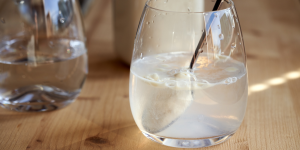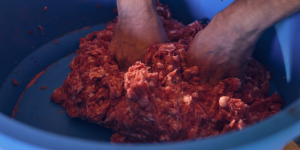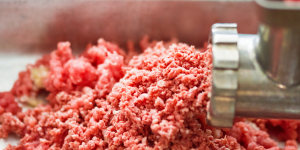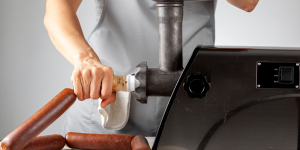
Chorizo
My chorizo recipe is a unique culinary creation, blending traditional spices with personal taste preferences to produce a sausage that is rich in flavor, perfectly balanced in spice, and versatile enough to enhance a variety of dishes with its distinct, savory warmth.
Equipment
- Gloves
- Natural Hog casing I usually use a 45mm Diameter casing but you can use anything you want. The larger the casing and the longer the curing time. You can also use collagen casings which work exceptionally well. If you decide on this, make sure you soak them for 10 minutes before using them.. Also keep in mind that they are not as elastic as natural casings so be mindful when stuffing.
- Butcher's twine This is only used to hang the sausage
- Sharp knife
- Waterproof labels
- Thin tip permanent marker
- Meat Grinder Use about an 8mm plate to get a rather course grind
- Fermenting Box This is simply a box that regulates both temperature and humidity during the fermenting process. If you don't have one, you can tightly wrap the salami in an oven that is turned off but with the light on. This will create an ideal environment for the cultures to do their magic.
- Waterproof Label
- Permanent Marker
- pH meter You can use Litmus Test Strips and although not as accurate, will give you a general idea.
Ingredients
Meat
- 1.2 kg Pork shoulder You want your meat to be at about a 30% fat to lean ratio. Do not use belly fat because it will tend to smear during the grinding process.
- 300 gr Pork back fat
Spices
- 38 grams Smoked Paprika
- 30 grams Salt
- 10 grams Garlic
- 8 grams Dried Oregano
- 8 grams Fennel seeds
- 75 ml White wine
- 0.5 gr Flora Italia starter culture (CHR Hensen) Use approximately 1/4 teaspoon per Kg (2.2 lbs) of meat
- 3.75 gr Instacure #1 OPTIONAL
This is nitrite salt which can assist with hindering bad bacteria and mold. This is totally option so only use it if you are worried about possible contamination.
Instructions
1 hour Before starting
- Wipe down all surfaces with a food grade disinfectant
- Throughout the entire preparation process, it's crucial to keep the meat very close to freezing temperature. Place the meat in the freezer initially, ensuring it remains partially but not fully frozen. Maintaining this near-freezing state is key; the colder the meat, the lower the risk of fat smearing, which is essential to prevent deterioration of the texture. This careful temperature control is vital for achieving the desired quality and consistency in the final product.
- Before beginning the meat preparation, it's essential to place the plate, screw, and all other parts of the grinder that come into contact with the meat in the freezer. Doing so will help maintain a low temperature throughout the grinding process. This precaution is crucial as it aids in dissipating any heat generated during grinding, ensuring that the meat stays as cold as possible. Keeping these components chilled is key to preserving the texture and quality of the meat, preventing any potential smearing or texture degradation that can occur from heat
- Dissolve the Flora Italia starter culture in 60 grams of distilled water (1/4 cup) distilled water and mix well. Chlorine can potentially deactivate the culture so in order to avoid any risks of this happening, we use distilled water or cold water that has been boiled (so chlorine free).

Meat Preparation
- In a large mixing bowl, combine the ground pork shoulder and pork fat.
- In a separate bowl, mix together all dry ingredients, add the mixture to the meat and mix well. You can now use right away or store in the refrigerator and let the flavors develop. I usually just use the mixture right away because the meat also develops flavor fermentation and curing.

- Grind the meat and fat

- Add the Flora Italia to the minced meat
- OPTIONALAdd the Nitrite Salt
- Using a sausage stuffer, stuff the meat ensuring that you keep it tight to avoid the formation of air pockets. Leave a small quantity of meat (the size of a small meatball) in order to be able to test the pH without having to poke the Chorizo.

- Poke the sausage with the disinfected sausage pricker (or disinfected needle) and make sure any surface air pockets are removed.
- Tie the ends of the sausage with twine and make a loop so it's possible to hang.
- Weigh each Chorizo and write down:1) Chorizo2) Date made3) initial Weight4) Target Weight (you can use the below calculator)
- Tightly wrap the test meat in cling film
- If using a fermentation box (like a Biltong box), you can simply hang the Chorizo and make sure they don't touch. We ideally want a temperature between 80-85F (26C-30C).If you don't have a fermentation box, tightly wrap the Chorizo in cling film and place in the oven that is turned off but has the light on.
- After 18 hours, unwrap the small test meat and test the pH. What we want to achieve is a pH between 4.9 and 5.2. If you cannot check the pH, you should be OK at the 20 hour mark.
- Remove from the fermentation box/oven and hang them in a curing location that should have about a 75%-80% humidity and about 55F-60F (13C-15C).
- Patiently wait for the Chorizo to cure, open and enjoy.